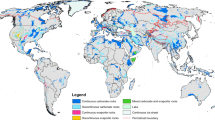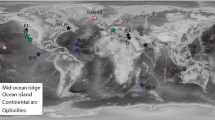Abstract
Use of the elemental geochemistry of carbonates for characterizing and distinguishing between temperate and tropical carbonate facies is in its infancy. In particular, apart from several Tasmanian examples, few elemental data exist for temperate carbonates. Analysis of the carbonate fraction of nearly 600 bulk samples of temperate Cenozoic limestones from New Zealand gives average values of Mg, 5500 ppm; Fe, 2500 ppm; Na, 1400 ppm; Sr, 550 ppm; and Mn, 500 ppm. Overall, the Mg and Sr contents are lower, and the Na, Fe, and Mn contents relatively higher, than is typical for tropical carbonates, whether ancient or modern. Bivariate plots involving combinations of these elements can thus be used to discriminate tropical from temperate carbonates, consistent with the temperature coefficient of the equilibrium constants for carbonate dissolution. The particular value of the Na−Sr plot in this discrimination is highlighted, the New Zealand limestones defining a “unique” temperature field having Sr values from 10–1000 ppm and Na values of 500–5000 ppm.
From the slopes of regression lines for various element-element relationships expected in marine, meteoric, and burial processes during limestone diagenesis, it is possible to construct summary elemental matrices that enable an overall assessment of the extent to which individual limestone formations have been subjected to each of these processes. Consistent with the interpretation of diagenetic history from other evidence, the geochemical results suggest that burial or burial/marine processes dominate the diagenetic character of most major occurrences of New Zealand Oligocene-Miocene limestones, but that a strong meteoric signal is also evident in many of the Plio-Pleistocene limestones of eastern North Island.
Similar content being viewed by others
References
ADABI, M.H., and RAO, C.P., 1991, Petrographic and geochemical evidence for original aragonite mineralogy of Upper Jurassic carbonates (Mozduran Formation), Sarakhs area, Iran:Sedimentary Geology, v. 72, p. 253–267.
AL-AASAM, I.S., and VEIZER, J., 1986, Diagenetic stabilization of aragonite and low-Mg calcite, I: trace elements in rudists:Journal of Sedimentary Petrology, v. 56, p. 136–152.
ANDERSON, J.M., 1984, The sedimentology and diagenesis of an Oligocene carbonate sequence (Nile Group), Westport to Punakaiki: MSc Thesis, Victoria University, Wellington, New Zealand (unpublished).
BATHURST, R.G.C., 1975, Carbonate sediments and their diagenesis (2nd ed.): Developments in Sedimentology, 12. Elsevier, Amsterdam.
BEU, A.G., HENDERSON, R.A., and NELSON, C.S., 1972, Notes on the taphonomy and paleoecology of New Zealand Tertiary Spatangoida:New Zealand Journal of Geology and Geophysics, v. 15, p. 275–286.
BONE, Y., and JAMES, N.P., 1993, Bryozoans as carbonate sediment producers on the cool-water Lacepede Shelf, southern Australia:Sedimentary Geology, v. 86, p. 247–271.
BOREEN, T., JAMES N., WILSON, C., and HEGGIE, C., 1993, Surficial cool-water carbonate sediments on the Otway continental margin, southeast Australia:Marine Geology, v. 112, p. 35–56.
BRAND, U., and MORRISON, J., 1987, Biochemistry of fossil marine invertebrates:Geoscience Canada, v. 14, p. 85–107.
BRAND, U., and VEIZER, J., 1980, Chemical diagenesis of a multicomponent carbonate system-I: Trace elements:Journal of Sedimentary Petrology, v. 50, p. 1219–1236.
BURDIGE, D.J., 1994, The biogeochemistry of manganese and iron reduction in marine sediments:Earth Science Reviews, v. 35, p. 249–284.
CAREY, J.S., MOSLOW, T.F., and BARRIE, J.V., 1995, Origin and distribution of Holocene temperate carbonates, Hecate Strait, western Canada continental shelf:Journal of Sedimentary Research, v. A65, p. 185–194.
CHAVE, K.E., 1967, Recent carbonate sediments: an unconventional view:Journal of Geological Education, v. 15, p. 200–204.
HARMSEN, F.J., 1985, Lithostratigraphy of Pliocene strate, Central and Southern Hawke’s Bay, New Zealand:New Zealand Journal of Geology and Geophysics, v. 28, p. 413–433.
HAYTON, S., 1995, Skeletal assemblages and diagenetic aspects of non-tropical Cenozoic limestones, South Island, New Zealand: MSc Thesis, University of Waikato, Hamilton, New Zealand (unpublished).
HAYTON, S., NELSON, C.S., and HOOD, S.D., 1995, A skeletal assemblage classification system for non-tropical carbonate deposits based on New Zealand Cenozoic limestones:Sedimentary Geology, v. 100, p. 123–141.
HAYWICK, D.W.N., 1990, Stratigraphy, sedimentology, paleoecology and diagenesis of the Petane Group (Plio-Pleistocene) in the Tangoio Block, Central Hawke’s Bay, New Zealand: PhD Thesis, James Cook University, North Queensland, Australia (unpublished).
HENRICH, R., FREIWALD, A., BETZLER, C., BADER, B., SCHÅFER, P., SAMTLEBEN, C., BRACHERT, T.C., WEHRMANN, A., ZANKL, H., and KÜHLMANN, D.H.H., 1995, Controls on modern carbonate sedimentation on warm-temperate to Arctic coasts, shelves and seamounts in the northern hemisphere: implications for fossil counterparts:Facies, v. 32, p. 71–108.
HOOD, S.D., 1993, Skeletal assemblages and diagenetic petrofacies of temperate-latitude limestones, North Island, New Zealand: MSc Thesis, University of Waikato, Hamilton, New Zealand (unpublished).
HOOD, S.D., and NELSON, C.S., 1996, Overview of cementation scenarios for New Zealand Cenozoic nontropical limestones:New Zealand Journal of Geology and Geophysics, v. 39, p. 109–122.
HORNIBROOK, N.deB., 1992, New Zealand paleoclimates: a review based on the distribution of some shallow water and terrestrial biota,in Tsuchi, R., and Ingle, J.C. (Jr), eds., Pacific-Neogene Environment, Evolution, and Events: Tokyo, University of Tokyo, p. 83–106.
JAMES, N.P., and BONE, Y., 1989, Petrogenesis of Cenozoic, temperate water calcarenites, south Australia: a model for meteoric/shallow burial diagenesis of shallow water calcite sediments:Journal of Sedimentary Petrology, v. 59, p. 191–204.
JAMES, N.P., and CHOQUETTE, P.W., 1990, Limestones-the meteoric diagenetic environment,in MCILREATH, I.A., and MORROW, D.W., eds., Diagenesis: Geoscience Canada 4, Ottawa, Runge Press, p. 35–73.
JAMES, N.P., BONE, Y., VON DER BORCH, C.C., and GOSTIN, V.A., 1992, Modern carbonate and terrigenous clastic sediments on a cool water, high energy, mid-latitude shelf: Lacepede, southern Australia:Sedimentology, v. 39, p. 877–903.
JENKYNS, H.C., GALE, A.S., and CORFIELD, R.M., 1994, Carbon and oxygen-isotope stratigraphy of the English Chalk and Italian Scaglia and its palaeoclimatic significance:Geological Magazine, v. 131, p. 1–34.
KAMP, P.J.J., HARMSEN, F.J., NELSON, C.S., and BOYLE, S.F., 1988, Barnacle-dominated limestone with giant cross-beds in a non-tropical, tide-swept, Pliocene forearc seaway, Hawke’s Bay, New Zealand:Sedimentary Geology, v. 60, p. 209–219.
KITT, W., 1962, Survey of limestone analyses 1917–1961: New Zealand Department of Scientific and Industrial Research D.L. Report 2060, 76 p.
LAND, L.S., and HOOPS, G.K., 1973, Sodium in carbonate sediments and rocks: a possible index to the salinity of diagenetic solutions:Journal of Sedimentary Petrology, v. 43, p. 614–617.
LAWRENCE, M.F., 1991, Early diagenetic concretions in the late Cretaceous Herring Formation, eastern Marlborough, New Zealand:Sedimentary Geology, v. 75, p. 125–140.
LEWIS, D.W., and BELLISS, S.E., 1984, Mid-Tertiary unconformities in the Waitaki Subdivision, North Otago:Journal of the Royal Society of New Zealand, v. 14, p. 251–276.
MARSHALL, J.D., 1992. Climatic and oceanographic isotope signals from the carbonate rock record and their preservation:Geological Magazine, v. 129, p. 143–160.
MILLIMAN, J.D., 1974. Marine Carbonates. Recent Sedimentary Carbonates, Part 1: New York, Springer-Verlag, 375 p.
MOORE, P.R., and BELLISS, S.E., 1979, The limestone resources of southern Hawke’s Bay and northen Wairarapa:New Zealand Geological Survey Report 87, 23 p.
MORGAN, P.G., 1919, The limestone and phosphale resources of New Zealand — Part 1 Limestone:New Zealand Geological Survey Bulletin 22, 316 p.
MORRISON, J.O., and BRAND, U., 1986, Geochemistry of Recent marine invertebrates:Geoscience Canada, v. 13, p. 237–254.
MORSE, J.W., and MACKENZIE, F.T., 1990, Geochemistry of Sedimentary Carbonates: Amsterdam, Elsevier, 707 p.
NATHAN, S., ANDERSON, HJ., COOK, R.A., HERZEI, R.H., HOSKINS, R.H., RAINE, J.I., AND SMALE, D., 1986, Cretaceous and Cenozoic sedimentary basins of the West Coast region, South Island, New Zealand:Nev Zealand Geological Survey Basin Studies 1.
NELSON, C.S., 1978, Temperate shelf carbonate sediments in the Cenozoic of New Zealand:Sedimentology, v. 25, p. 737–771.
NELSON, C.S., ed., 1988a, Non-tropical Shelf Carbonates-Modern and Ancient:Sedimentary Geology, v. 60, 367 p.
NELSON, C.S., 1988b, An introductory perspective on nontropical shelf carbonates:Sedimentary Geology, v. 60, p. 3–12.
NELSON, C.S., and SMITH, A.M., 1996, Stable oxygen and carbon isotope compositional fields for skeletal and diagenetic components in New Zealand Cenozoic nontropical carbonate sediments and limestones: a synthesis and review:New Zealand Journal of Geology and Geophysics, v. 39, p. 93–107.
NELSON, C.S., HARRIS, G.J., and YOUNG, H.R., 1988a, Burial-dominated cementation in non-tropical carbonates of the Oligocene Te Kuiti Group, New Zealand:Sedimentary Geology, v. 60, p. 233–250.
NELSON, C.S., HYDEN, F.M., KEANE, S.L., LEASK, W.L., and GORDON, DP., 1988b, Application of bryozoan zoarial growth-form studies in facies analysis of non-tropical carbonate deposits in New Zealand:Sedimentary Geology, v. 60, p. 301–322.
NELSON, C.S., KEANE, S.L., and HEAD, P.S., 1988c Non-tropical carbonate deposits on the modern New Zealand shelf:Sedimentary Geology, v. 60, p. 71–94.
RAO, C.P., 1981, Geochemical differences between tropical (Ordovician) and subpolar (Permian) carbonates, Tasmania, Australia:Geology, v. 9, p. 205–209.
RAO, C.P., 1986, Geochemistry of temperate-water carbonates, Tasmania, Australia:Marine Geology, v. 71, p. 363–370.
RAO, C.P., 1990a, Geochemical characteristics of cooltemperate carbonates, Tasmania, Australia:Carbonates and Evaporites, v. 5, p. 209–221.
RAO, C.P., 1990b, Petrography, trace elements and oxygen and carbon isotopes of Gordon Group carbonates (Ordovician), Florentine Valley, Tasmania, Australia:Sedimentary Geology, v. 66, p. 83–97.
RAO, C.P., 1991, Geochemical differences between subtropical (Ordovician), temperate (Recent and Pleistocene) and sub-polar (Permian) carbonates, Tasmania, Australia:Carbonates and Evaporites, v. 6, p. 83–106.
RAO, C.P., and ADABI, M.H., 1992, Carbonate minerals, major and minor elements and oxygen and carbon isotopes and their variation with water depth in cool, temperate carbonates, Western Tasmania, Australia:Marine Geology, v. 103, p. 249–272.
RAO, C.P., and JAYAWARDANE, J., 1994, Major minerals, elemental and isotopic composition in modern temperate shelf carbonates, Eastern Tasmania, Australia: Implication for the occurrence of extensive ancient non-tropical carbonates:Palaeogeography, Palaeoclimatology, Palaeoecology, v. 107, p. 49–63.
RAO, C.P., and AMINI, Z.Z., 1995, Faunal relationship to grain-size, mineralogy and geochemistry in Recent temperate shelf carbonates, western Tasmania, Australia:Carbonates and Evaporites, v. 10, p. 114–123.
RENARD, M., 1984, Trace element contents of carbonate sediments from the Mazagan escarpment off central Morocco (Cynaz, 1982):Oceanologica Acta, v. 1984, p. 153–159.
RENARD, M., 1986, Pelagic carbonate chemostratigraphy (Sr, Mg,18O,13C):Marine Micropaleontology, v. 10, p p. 117–164.
ROBINSON, P., 1980, Determination of calcium, magnesium, manganese, strontium, sodium and iron in the carbonate fraction of limestones and dolomites:Chemical Geology, v. 28, p. 135–146.
SCUDELER BACCELLE, L.S., and MARRUSSO, F., 1983, Trace elements in Cenozoic algal limestones of the Venetian region: Mn2+−Sr2+ negative correlation:Bollettino della Societa Paleontologica Italiana, v. 22, p. 103–107.
TUCKER, M.E., and WRIGHT, V.P., 1990, Carbonate Sedimentology: Blackwells Scientific Publications, London.
VEIZER, J., 1983, Chemical diagenesis of carbonates: theory and application of trace element technique,in Stable Isotopes in Sedimentary Geology, SEPM Short Course 10: p. 3–1 to 3–100.
WINFIELD, P.R., 1995, Elemental geochemistry of non-tropical Cenozoic limestones in New Zealand: MSc Thesis, University of Waikato, Hamilton, New Zealand (unpublished).
WINEFIELD, P.R., NELSON, C.S., Hood, S.D., and Hodder, A.P.W., in prep. Burial, Marine and meteoric diagenetic trends in Neogene temperate limestones of eastern North Island, New Zealand.
Author information
Authors and Affiliations
Rights and permissions
About this article
Cite this article
Winefield, P.R., Nelson, C.S. & Hodder, A.P.W. Discriminating temperate carbonates and their diagenetic environments using bulk elemental geochemistry: A reconnaissance study based on New Zealand Cenozoic limestones. Carbonates Evaporites 11, 19–31 (1996). https://doi.org/10.1007/BF03175782
Received:
Accepted:
Published:
Issue Date:
DOI: https://doi.org/10.1007/BF03175782




